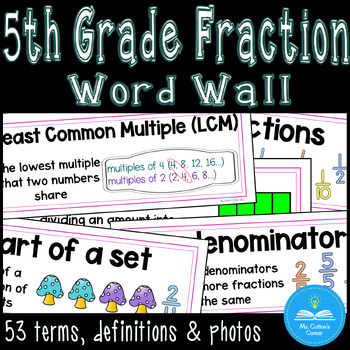Fractions - 53 Math Vocabulary Word Wall Cards - Bulletin Board - low Prep
- PDF
Description
Are you looking for a comprehensive set of Math Vocabulary Word Cards to teach the important vocabulary terms about Fractions? This set includes 53 Word Cards - each with a definition and a high-quality image to teach the concept of the word. The images add context to the definition, and often feature diagrams and mathematical situations that bring the word to life! Building vocabulary is essential for helping your students master key concepts.
These vocabulary cards will help your students understand concepts such as comparing fractions, finding equivalent fractions, and fractional models such as the set model, visual model, area model and fractions on a number line.
With these full color diagrams, illustrations and photos, you can easily teach your students important Math terms such as numerator, denominator, decompose, reciprocal, equivalent, and more! (For a complete list, check out the preview!) Create a beautiful bulletin board in minutes - that is also a terrific teaching tool.
Building a strong vocabulary increases reading comprehension as well as understanding of the key Math concepts. This Word Wall will help you improve reading AND Math understanding - win win!
Looking for more Word Walls? Be sure to check out my growing collection of Science, Math, English and Social Studies sets!
The set includes these 53 Vocabulary terms:
- benchmark fraction
- common denominator
- common factor
- common multiple
- decimal fraction
- decompose
- denominator
- division
- eighths
- equal groups
- equal share
- equivalence
- equivalent frations
- fifths
- fourths
- fraction
- fractional side
- greatest common denominator
- greatest common factor (GCF)
- half/halves
- hundredths
- improper fraction
- least common multiple
- like denominators
- lowest terms
- mixed number
- multiplicative inverse
- ninths
- numerator
- part of a set
- part of a whole
- partitioning
- percent
- proper fraction
- quarter
- recriprocal
- reduce
- sevenths
- simplest form
- simplest terms
- simplify fractions
- sixths
- tenths
- thirds
- tiling
- twelfths
- unit fraction
- unlike denominator
- visual fraction models
- area model
- linear model
- set model
- whole number
For tips and ideas to bring this to your classroom, check out this blog post at Ms. Cotton's Corner.com.
Be sure to check out my growing collection of Word Walls!
5th Grade Science Word Wall Bundle
Brain and Growth Mindset Word Wall
*************************************************************************************************************
Please follow me! All new uploads are 50% off for the first 48 hours, and TPT lets you know when I have a new product!
****************************************************************************************************************
I always appreciate your feedback and suggestions. Please leave a rating and comments to help me continually improve.
Please contact me with any questions.
Thank you and Happy teaching!
Susan





